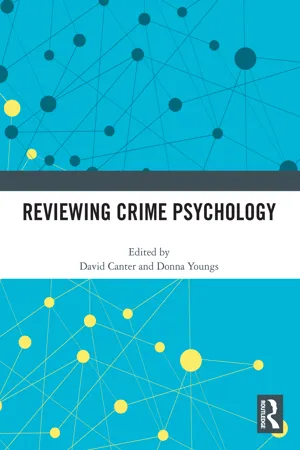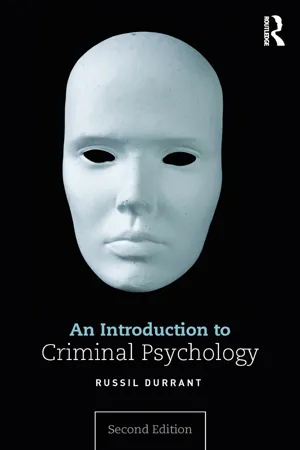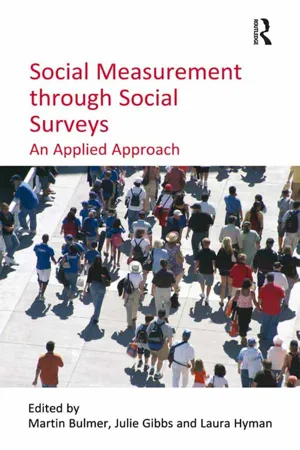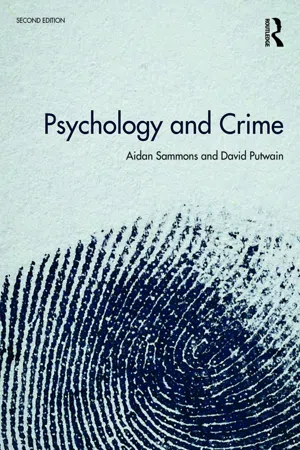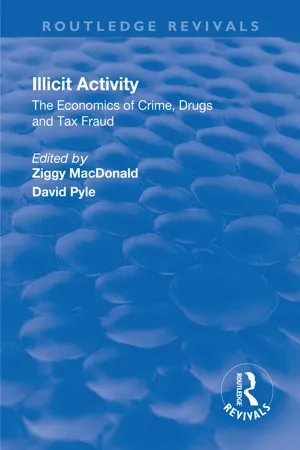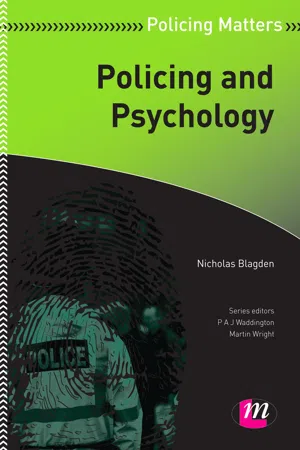Psychology
How Crime is Measured
Crime is measured through various methods, including official statistics, victimization surveys, and self-report surveys. Official statistics are collected by law enforcement agencies and provide data on reported crimes. Victimization surveys involve asking individuals about their experiences as crime victims. Self-report surveys involve individuals reporting their own criminal activities. Each method has its strengths and limitations in capturing the true extent of crime.
Written by Perlego with AI-assistance
Related key terms
1 of 5
8 Key excerpts on "How Crime is Measured"
- eBook - ePub
- David Canter, Donna Youngs, David Canter, Donna Youngs(Authors)
- 2020(Publication Date)
- Routledge(Publisher)
In studying crime, researchers struggle with a variable that is inherently difficult to measure (Osgood, McMorris, & Potenza, 2002). Nevertheless, researchers have developed multiple ways of measuring delinquency and criminal conduct, giving rise to the criminological knowledge that is essential in all developed societies (e.g. crime statistics, criminal careers, risk factors, intervention effectiveness, etc.). Unfortunately, current measures of crime are recognized as being deeply flawed, and it has become a common practice in criminological studies to attach warning labels about potential validity problems and to point out that different methods may result in different estimates of crime (Enzmann, 2013).In this article, we present the major issues in measuring crime, a brief historical overview of the development of measurement techniques and a review of the primary methods of measuring criminal conduct. In describing these different methodologies, we will consider the advantages and limitations of each method, in order to achieve a broad and integrated understanding about crime and delinquency methods of measurement.Definition and units of measurement
The generally accepted definition of crime seems to be a legal definition: ‘any act committed in violation of a law that prohibits it and authorizes punishment for its commission’ (Wilson & Herrnstein, 1985, p. 22). However, this definition presents several problems; for example, laws have to be understood in time and space. Because laws are subject to change, many behaviours that were classified as crimes 20 years ago may not be considered as crimes today, and vice versa. Moreover, since laws are the subject of political decisions, what is considered crime in one country may not be viewed as crime in another, which is a potential limitation for comparative research between different countries. For example, in Portugal, the acquisition, possession, and use of small quantities of drugs were decriminalized in 2001 (Greenwald, 2009). Although drug usage is still prohibited, no punishment is applied, so drug usage is not a crime in Portugal. As a result, this might constitute a source of bias when comparing criminal records between Portugal and other countries where drug usage is a crime, as well as within Portugal before and after 2001. - Marko Nikolic(Author)
- 2019(Publication Date)
- Society Publishing(Publisher)
Measuring Crime 6 CONTENTS 6.1. Introduction .................................................................................... 116 6.2. Measuring Crime And Crime Victimization ..................................... 118 6.3. The Measurement of White-Collar Crime Using Uniform Crime Reporting (UCR) Data .......................................... 122 6.4. Quantitative Methodologies To Measure Non-Economic Violence ....................................................................................... 123 6.5. The Official Mode of Measuring Crime: The Uniform Crime Reports (UCR) .................................................................... 125 6.6. Challenges Associated With Measurement of Crime ........................ 127 References ............................................................................................. 133 Research Methods in Criminal Justice and Criminology 116 Crime is that one thing which is full of complexities and for any individual, whether an expert or a researcher, it is a difficult task to measure crime. Crime victimization could be defined as that situation wherein an individual gets prone to a crime and has an extensive impact over a long period of time on the victim. This chapter would help the readers to understand the meaning of victimization and all those methodologies that are required to measure economic violence, non-economic violence, and crime. The chapter highlights the official mode of measuring crime which was defined by the Uniform Crime Reports (UCR). Also, discussed are the challenges that are associated with the measurement of crime. 6.1. INTRODUCTION Criminology is the scientific study of the nature, extent, management, causes, control, consequences, and prevention of criminal behavior, both on individual and social levels.- eBook - ePub
- Russil Durrant(Author)
- 2018(Publication Date)
- Routledge(Publisher)
Given the strengths and limitations of the three types of approach for measuring crime and criminal behaviour, how should we go about determining the nature and prevalence of crime in society? As with other types of research enquiry, the best approach is to draw on a diverse range of research methods rather than to rely predominantly or exclusively on one source of data. If we can demonstrate similar patterns across different sources of data then we are in a stronger position to claim that the particular phenomenon that we are interested in is a ‘robust’ one and not simply an artefact of the particular source of data. Throughout this book we will draw on a range of different sources of information about crime, alongside various different research methodologies for understanding criminal behaviour.REVIEW AND REFLECT
1 How would you define ‘crime’?2 What are some of the advantages and disadvantages of using official crime statistics?WHAT IS CRIMINAL PSYCHOLOGY?
This book is centrally concerned with the application of psychology to our understanding of criminal behaviour. Let us pause for a moment to reflect on what this actually entails. As every introductory psychology textbook will quickly tell us, psychology is ‘the science of mental processes and behavior’ (e.g., Kosslyn & Rosenberg, 2004, p. 4). Criminology textbooks are rather less concise or uniform in how they define their discipline, but, broadly speaking, criminology is defined as the study of crime, criminal behaviour, and responses to crime (e.g., Newburn, 2013). Criminal psychology, then, critically involves the use of psychology as a science to advance our understanding of the causes of crime. Psychology here refers to the academic discipline of psychology (which includes the study, among other things, of brain processes, development, cognition, personality, social influence, and culture) not just peoples’ thinking process and personality (as in the psychological level of analysis - eBook - ePub
Social Measurement through Social Surveys
An Applied Approach
- Julie Gibbs, Martin Bulmer(Authors)
- 2016(Publication Date)
- Routledge(Publisher)
Chapter 3Measuring Crime Ian Brunton-Smith and Jonathan AllenMeasures of the extent of crime provided by social surveys have become a central part of criminal statistics in the UK, offering an alternative picture of crime to police recorded crime figures and court statistics. These survey-based methods have painted a very different picture of crime, suggesting it is considerably more widespread than official measures would indicate, and have significantly advanced criminological theory and government policy. Yet despite the advances that have been made as a result of a crime survey approach, public confidence in these alternative sources of criminal statistics has recently begun to slide. Shifting definitions of different offences, and the proximity of those collecting data to the government, has led people to question their value as independent counts of crime, or the extent that they can provide consistent information over time. This loss of confidence prompted the commissioning of two independent review panels to assess the accuracy of existing survey measures, and how to improve them to raise public confidence (Smith, 2006; Statistics Commission, 2006). Since their completion, these independent reviews have heralded the extension of the British Crime Survey to under 16s, and led to renewed efforts to maximize comparability with recorded crime figures. Crime surveys, then, remain firmly in the public gaze, with their methods continuing to fall under intense scrutiny. This makes it essential for researchers to understand the methods employed and the rationale behind their introduction, but also the limitations with this type of approach and how these can impact on the types of measure produced.In this chapter we provide an overview of the survey-based methods of counting crime, looking both at victimization surveys and self-reported offending surveys. These survey-based methods are discussed within the broader historical and social context of counting crime, helping to explain why they were introduced and what they offer to a fuller understanding of crime. Taking victimization and offending surveys in turn, we detail the rationale behind their introduction, the specific mechanisms employed to generate accurate counts of crime, and the limitations associated with each. Like all survey-based methods, measuring crime with social surveys comes with a number of health warnings, with non-response, coverage problems, and question-wording issues meaning that they can only present a partial picture of crime. As such, we present them here as a complement to official crime statistics, serving to further illuminate the extent of the crime problem in society. - eBook - PDF
Psychology and Crime
2nd edition
- Aidan Sammons, David Putwain(Authors)
- 2018(Publication Date)
- Routledge(Publisher)
This being the case, it is difficult to see how consensus could be achieved among researchers about the acts they ought to be studying. Different researchers resolve this issue in different ways but many follow the suggestions of Blackburn (1993) who makes several useful recommendations. First, ‘criminal behaviour’ should be defined in terms of the conscious breaking of rules. That is, the people of interest to criminological psychology are those who know what the rules are, but do something different. This inevitably means that some chapter 2 Defining and measuring crime 8 behaviour that is legally permissible is nonetheless of interest to psychologists and criminologists whereas other behaviour that is technically criminal is not. So those who park their cars in the spaces reserved for parents with children are not com-mitting a crime but might still be of interest because there is an underlying simi-larity between this act and other acts that are illegal. This approach allows us to recognise the continuity between, for example, conduct problems in childhood and later delinquency and criminality in adolescence and adulthood. Second, Blackburn recommends that criminological psychology should focus, in the main, on crime as legally defined. The problems this raises notwithstanding, it at least offers research-ers a clear framework on which they can agree. The majority of ‘mainstream’ criminological psychologists accept this but not all. Those who adopt one of the more critical perspectives on criminological psy-chology take issue with this apparent willingness to admit, on the one hand, that ‘crime’ and ‘criminal’ are social constructs but, on the other hand, treat them as if they were natural or objective facts. Critical perspectives raise questions about how the social construction of crime relates to issues of power, gender and race in society (see Chapter 12). - eBook - PDF
Crime and Law
Theory, Research, and Policy
- Anne Wade(Author)
- 2019(Publication Date)
- Society Publishing(Publisher)
PSYCHOLOGY AND CRIME CHAPTER 2 CONTENTS Abstract ................................................................................................... 28 2.1. Introduction ...................................................................................... 28 2.2. Psychoanalytic Theory ...................................................................... 33 2.3. Cognitive and Behavioral Psychology ............................................... 37 2.4. Personality and Crime ....................................................................... 42 2.5. Intelligence and Crime ...................................................................... 48 Crime and Law: Theory, Research, and Policy 28 ABSTRACT The application of psychology in the field of crime may be a new phenomenon in recent criminal investigations. This relationship sometimes makes it difficult to determine the boundaries of criminology and psychology. Books that deal with psychology and crime can bear different headings such as crime and psychology, criminal psychology, legal psychology, evidence psychology, or forensic psychology. There is an unending overlap between sociology, psychology, and criminology which has created a common pattern in the application of psychology to understand crime and the criminal justice system. When talking about psychology and crime, we put into perspective the offenders, the police, witnesses, and victims. This chapter deals with the overall patterns displayed by offenders and to some extent the witnesses and those directly affected by criminal acts. 2.1. INTRODUCTION The application of psychology in the criminal justice system is what is professionally called forensic psychology. A German psychologist, Hugo Munsterberg is the one who pioneered the application of criminal psychology into criminology. He conducted research studies that covered false evidence, witness memory, and hypnosis which was used to extract evidence. - eBook - ePub
Illicit Activity: The Economics of Crime, Drugs and Tax Fraud
The Economics of Crime, Drugs and Tax Fraud
- Ziggy Macdonald, David Pyle, Ziggy Macdonald, David Pyle, Ziggy Macdonald, David J Pyle(Authors)
- 2018(Publication Date)
- Taylor & Francis(Publisher)
3. Measurement Error in Economic Models of Crime DEREK DEADMAN, STEPHEN PUDNEY AND DAVID PYLE Introduction In Chapter Two we reported estimates of a time-series econometric model, which linked the incidence of crime to various criminal justice, demographic and economic variables. This model indicated that measures of both the certainty and severity of punishment as well as economic indicators such as unemployment and real consumers' expenditure appeared to exert significant influences upon the incidence of residential burglary in England and Wales during the post-war period. However, modelling of this kind has been criticised by criminologists and sociologists, who argue that such studies make use of official statistics of recorded crime, which are well known to be error prone. If the crime data are riddled with measurement errors, how can the results obtained by using such data produce reliable judgements about the determinants of crime and the effectiveness of criminal justice policies? Is statistical modelling using crime data a complete waste of time? (for general discussions of crime data see Coleman and Moynihan, 1996; Jupp, 1995; Maguire, 1994). It is generally accepted that official statistics of crime (or recorded crime, as it is sometimes called) measure only a proportion of all crimes that take place each year (see Table 3.1). It has been argued that underreporting can happen for a number of reasons. For example, victims may fail to report crimes to the police; either because they think that the police will do nothing about them or even if they did there is little prospect of ever regaining their property. Alternatively, the police may decide not to record as crimes acts that are reported to them by members of the public, because they feel that either there is little prospect of catching the offender or the offence is so minor that it would be a waste of their time to investigate it - eBook - ePub
- Nicholas Blagden(Author)
- 2012(Publication Date)
- Learning Matters(Publisher)
2Psychological theories of crime and criminal behaviour
CHAPTER OBJECTIVES
By the end of this chapter you should be able to:- understand some of the main psychological theories of crime and criminal behaviour;
- apply these theories to case studies and real-world policing examples;
- think critically about psychological theories of crime and their application to criminal behaviour.
LINKS TO STANDARDSThis chapter provides opportunities for links with the following Skills for Justice, National Occupational Standards (NOS) for Policing and Law Enforcement 2008.AE1 Maintain and develop your knowledge, skills and competence. HA2 Manage your own resources and professional development. HF15 Provide information to support decision making. With the introduction of the Qualification and Credit Framework (QCF), it is likely that the term ‘National Occupational Standards’ will change. At the time of writing, it is not clear what the new title will be, although it is known that some organisations will use the term ‘QCF assessment units’.Links to current NOS are provided at the start of each chapter; however, it should be noted that these are currently subject to review and it is recommended that you visit the Skills for Justice website to check the currency of all the NOS provided: www.skillsforjustice-nosfinder.com .Introduction
Why people commit crime is something that academics and practitioners have tried to explain for many years. This chapter explores some of the main psychological theories that can help explain and predict why some people commit crime and others do not. The chapter aims to provide an in-depth summary of some of the key theories, including psycho-biological, social and cognitive-behavioural approaches. Through an understanding of these theories students, particularly those pursuing careers within law enforcement agencies, will gain an insight into the many factors that influence criminal behaviour. An understanding of these theories will broaden students’ and trainee police officers’ perceptions on what (if anything concrete) causes offending behaviour.
Index pages curate the most relevant extracts from our library of academic textbooks. They’ve been created using an in-house natural language model (NLM), each adding context and meaning to key research topics.
